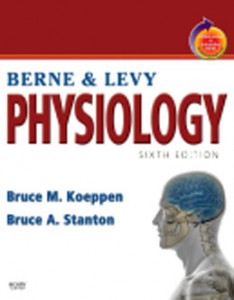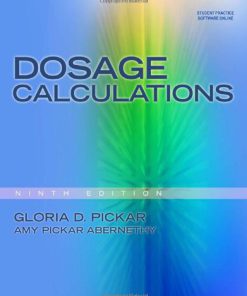Test Bank for Berne and Levy Physiology, 6th Edition: Koeppen
$35.00 Original price was: $35.00.$26.50Current price is: $26.50.
Test Bank for Berne and Levy Physiology, 6th Edition: Koeppen
Instant download Test Bank for Berne and Levy Physiology, 6th Edition: Koeppen pdf docx epub after payment.

Product Details:
- ISBN-10 : 032307362X
- ISBN-13 : 978-0323073622
- Author: Bruce Koeppen; Bruce Stanton
Berne and Levy Physiology has long been respected for its scientifically rigorous approach and now includes major updates to bring you all of the latest knowledge in the field. Bruce M. Koeppen and Bruce A. Stanton present a honed and shortened edition that emphasizes the core information needed by students of physiology today and features a full-color design and artwork to enhance readability and enrich your comprehension of every concept. With access to the full contents online at Student Consult, this time-honored book delivers an in-depth understanding of physiology more powerfully and effectively than ever before.
Table Of Contents:
-
Section 1: Cellular Physiology
-
1: Principles of Cell and Membrane Function
-
Overview of Eukaryotic Cells
-
Vesicular Transport
-
Electrochemical Gradient
-
Osmosis and Osmotic Pressure
-
Key Points
-
Additional Readings
-
2: Homeostasis: Volume and Composition of Body Fluid Compartments
-
Concept of Steady-State Balance
-
Volumes and Composition of Body Fluid Compartments
-
Maintenance of Cellular Homeostasis
-
Principles of Epithelial Transport
-
Key Concepts
-
Additional Readings
-
3: Signal Transduction, Membrane Receptors, Second Messengers, and Regulation of Gene Expression
-
Cell-to-Cell Communication
-
Receptors
-
Receptors and Signal Transduction Pathways
-
Regulation of Gene Expression by Signal Transduction Pathways
-
Key Points
-
Additional Readings
-
Section 2: The Nervous System
-
4: The Nervous System: Introduction to Cells and Systems
-
Cellular Components of the Nervous System
-
The Peripheral Nervous System
-
The Central Nervous System
-
Nervous Tissue Reactions to Injury
-
Key Concepts
-
Additional Reading
-
5: Generation and Conduction of Action Potentials
-
Membrane Potentials
-
Suprathreshold Response: The Action Potential
-
Conduction of Action Potentials
-
Key Concepts
-
Additional Readings
-
6: Synaptic Transmission
-
Electrical Synapses
-
Chemical Synapses
-
Synaptic Integration
-
Modulation of Synaptic Activity
-
Neurotransmitters
-
Neurotransmitter Receptors
-
Key Concepts
-
Additional Reading
-
7: The Somatosensory System
-
Subdivisions of the Somatosensory System
-
Discriminatory Touch and Proprioception
-
Thalamic and Cortical Somatosensory Areas
-
Pain and Temperature Sensation
-
Transduction in the Somatosensory System
-
Centrifugal Control of Somatosensation
-
Key Concepts
-
Additional Readings
-
8: The Special Senses
-
The Visual System
-
The Auditory and Vestibular Systems
-
The Chemical Senses
-
Key Points
-
Additional Reading
-
9: Organization of Motor Function
-
Principles of Spinal Cord Organization
-
Descending Motor Pathways
-
Brainstem Control of Posture and Movement
-
Motor Control by the Cerebral Cortex
-
Motor Control by the Cerebellum
-
Motor Control by the Basal Ganglia
-
Eye Movement
-
Key Points
-
Additional Readings
-
10: Integrative Functions of the Nervous System
-
The Cerebral Cortex
-
Key Points
-
Additional Reading
-
11: The Autonomic Nervous System and Its Central Control
-
Organization of the Autonomic Nervous System
-
Autonomic Ganglia
-
Neurotransmitters
-
Central Control of Autonomic Function
-
Key Points
-
Additional Readings
-
Section 3: Muscle
-
12: Skeletal Muscle Physiology
-
Skeletal Muscle Physiology
-
Organization of Skeletal Muscle
-
Control of Skeletal Muscle Activity
-
Skeletal Muscle Types
-
Modulation of the Force of Contraction
-
Modulation of Force by Reflex Arcs
-
Skeletal Muscle Tone
-
Energy Sources During Contraction
-
Oxygen Debt
-
Fatigue
-
Growth and Development
-
Denervation, Reinnervation, and Cross-Innervation
-
Response to Exercise
-
Delayed-Onset Muscle Soreness
-
Biophysical Properties of Skeletal Muscle
-
Key Points
-
Additional Readings
-
13: Cardiac Muscle
-
Basic Organization of Cardiac Muscle Cells
-
Control of Cardiac Muscle Activity
-
Regulation of the Force of Contraction
-
Cardiac Muscle Metabolism
-
Cardiac Muscle Hypertrophy
-
Key Points
-
Additional Readings
-
14: Smooth Muscle
-
Overview of Smooth Muscle
-
Structure of Smooth Muscle Cells
-
Control of Smooth Muscle Activity
-
Innervation of Smooth Muscle
-
Regulation of Contraction
-
Regulation of Myoplasmic Calcium Concentration
-
Development and Hypertrophy
-
Synthetic and Secretory Functions
-
Biophysical Properties of Smooth Muscle
-
Key Concepts
-
Additional Reading
-
Section 4: The Cardiovascular System
-
15: Overview of Circulation
-
The Heart
-
The Cardiovascular Circuit
-
Blood Vessels
-
Key Points
-
Additional Readings
-
16: Elements of Cardiac Function
-
Electrical Properties of the Heart
-
Conduction in Cardiac Fibers
-
Cardiac Excitability
-
Effects of Cycle Length
-
Natural Excitation of the Heart and the Electrocardiogram
-
Electrocardiography
-
Arrhythmias
-
The Cardiac Pump
-
Key Points
-
Additional Readings
-
17: Properties of the Vasculature
-
Hemodynamics
-
The Arterial System
-
The Venous System
-
Microcirculation and Lymphatic System
-
Coronary Circulation
-
Cutaneous Circulation
-
Skeletal Muscle Circulation
-
Cerebral Circulation
-
Intestinal Circulation
-
Hepatic Circulation
-
Fetal Circulation
-
Key Points
-
Additional Readings
-
18: Regulation of the Heart and Vasculature
-
Regulation of Heart Rate and Myocardial Performance
-
Nervous Control of the Heart Rate
-
Regulation of Myocardial Performance
-
Regulation of the Peripheral Circulation
-
Key Points
-
Additional Readings
-
19: Integrated Control of the Cardiovascular System
-
Regulation of Cardiac Output and Blood Pressure
-
Vascular Function Curve
-
Relating the Cardiac Function Curve to the Vascular Function Curve
-
A More Complete Theoretical Model: The Two-Pump System
-
Role of the Heart Rate in Control of Cardiac Output
-
Ancillary Factors That Affect the Venous System and Cardiac Output
-
Interplay of Central and Peripheral Factors in Control of the Circulation
-
Key Points
-
Additional Readings
-
Section 5: The Respiratory System
-
20: Introduction to the Respiratory System
-
Lung Anatomical Structure/Function Relationships
-
Circulatory Systems in the Lung
-
Innervation
-
Lung Embryology, Development, Aging, and Repair
-
Key Points
-
Additional Readings
-
21: Static Lung and Chest Wall Mechanics
-
Pressures in the Respiratory System
-
How a Pressure Gradient Is Created
-
Lung Volumes and Their Measurement
-
Measurement of Lung Volumes
-
Determinants of Lung Volume
-
Pressure-Volume Relationships
-
Lung Compliance
-
Surface Tension and Surfactant
-
Key Points
-
Additional Readings
-
22: Dynamic Lung and Chest Wall Mechanics
-
Dynamic Lung Mechanics
-
Work of Breathing
-
Key Concepts
People also search:
Berne and Levy Physiology
Berne and Levy Physiology Koeppen
Berne and Levy Physiology Koeppen 6th
Berne and Levy Physiology Koeppen 6th Test Bank
Test Bank for Berne and Levy Physiology, 6th Edition: Koeppen Download











